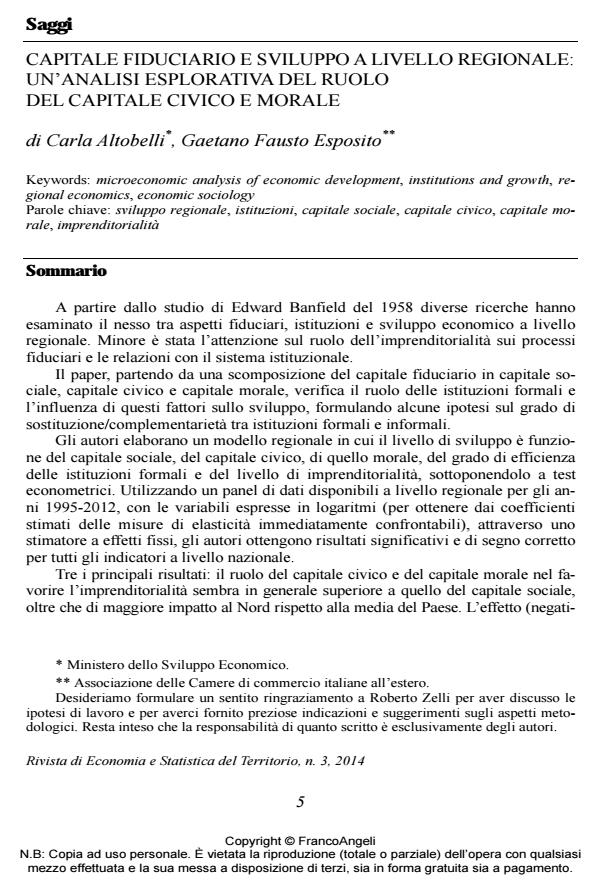Trust-based relations and regional development: a study on the role of civic and moral capital
Journal title RIVISTA DI ECONOMIA E STATISTICA DEL TERRITORIO
Author/s Carla Altobelli, Gaetano Fausto Esposito
Publishing Year 2015 Issue 2014/3
Language Italian Pages 35 P. 5-39 File size 374 KB
DOI 10.3280/REST2014-003001
DOI is like a bar code for intellectual property: to have more infomation
click here
Below, you can see the article first page
If you want to buy this article in PDF format, you can do it, following the instructions to buy download credits

FrancoAngeli is member of Publishers International Linking Association, Inc (PILA), a not-for-profit association which run the CrossRef service enabling links to and from online scholarly content.
Starting from Edward Banfield’s study (1958), several papers have examined the relations between trust, institutions and regional economic development, while less attention has been paid to the entrepreneurship’s role on trust-based relations with the institutional system. The aim of this paper is twofold: firstly, to analyze the role of formal institutions; secondly, to measure their influence on the development level. Objectives Starting from Edward Banfield’s study (1958), several papers have examined the relations between trust, institutions and regional economic development, while less attention has been paid to the entrepreneurship’s role on trust-based relations with the institutional system. The aim of this paper is twofold: firstly, to analyze the role of formal institutions; secondly, to measure their influence on the development level. Method and Results According to the regional model defined by the authors, the development level is determined by: social, civic and moral capital, efficiency of formal institutions and entrepreneurial capacity. Referring to a regional data set (1995-2012) regarding Italy case study, the authors have reached relevant results for all the indicators by applying a fixed effects estimator. From the analysis emerge three insights: the civic and moral capital contribution to the entrepreneurial development is higher than the social capital one. Compared to the national average, the inefficiency of formal institutions penalizes more the South of Italy, while it was not possible to draw up a cogent and overall conclusion about the North area. In the South regions, the entrepreneurial initiative plays a key role, especially in the areas where the GDP per capita is lower. Conclusions In these Regions with a low level of trust-based relations, the efficiency of formal institutions and the entrepreneurial initiative may have an important influence on the development level. If the policies for the South will be directed to boost their effectiveness, they will promote economic growth and reduce the gap within the country
Keywords: Microeconomic analysis of economic development, institutions and growth, regional economics, economic sociology
Jel codes: O12, O43, R11, Z13.
- Innovative Business Development—A Global Perspective Fabio Musso, Gaetano Fausto Esposito, pp.219 (ISBN:978-3-030-01877-1)
Carla Altobelli, Gaetano Fausto Esposito, Capitale fiduciario e sviluppo a livello regionale: un’analisi esplorativa del ruolo del capitale civico e morale in "RIVISTA DI ECONOMIA E STATISTICA DEL TERRITORIO" 3/2014, pp 5-39, DOI: 10.3280/REST2014-003001